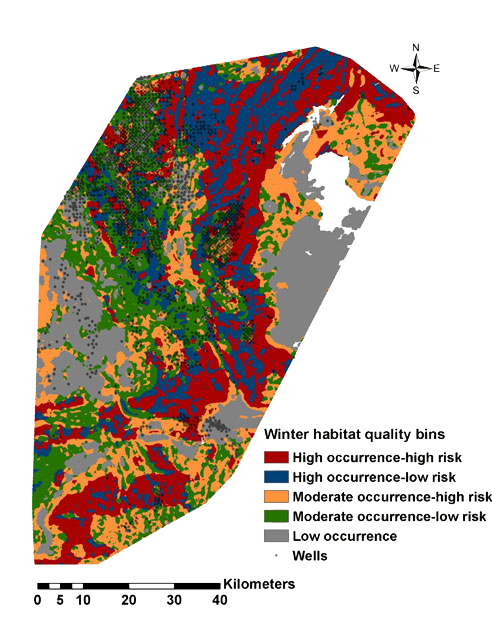

Dr. Jeffrey L Beck
Dept of Ecosystem Science and Management
Agriculture Building 2004
Department #3354
1000 E. University Ave
Laramie, WY 82071
Phone: (307) 766-6683
Fax: (307) 766-6403
Email: jlbeck@uwyo.edu
Prioritizing habitats that provide the best options for the persistence of sensitive species in human-modified landscapes is a critical concern for conservation. Linking occurrence and fitness parameters across multiple spatial scales provides an approach to address habitat prioritization for species of concern in disturbed habitats. To demonstrate the usefulness of this approach, we generated resource selection and survival risk models as a framework to quantify habitat value for wintering female greater sage-grouse (Centrocercus urophasianus) inhabiting a 6,093 km2 study area in northwest Colorado and south-central Wyoming, USA, being developed for oil and natural gas reserves. Our approach allowed us to evaluate the relative influence of anthropogenic development and environmental attributes characterizing a large landscape on habitat selection and habitat-specific survival in winter for female sage-grouse. When combined, these models provided a spatial representation of habitat quality to inform management and conservation of critical wintering habitats (see accompanying figure). We used 537 locations from 105 radio-marked female grouse obtained from 18 fixed-wing flights across winters 2007–2008, 2008–2009, and 2009–2010. Wintering sage-grouse selected areas with higher wetness potential (0.75-km² scale), intermediate (quadratic form) total shrub cover (18.83-km2 scale), higher variability in shrub height (18.83-km² scale), and less variability in Wyoming big sagebrush (Artemisia tridentata wyomingensis; 4.71-km² scale) cover and total shrub cover (18.83-km2 scale). Anthropogenic surface disturbance (0.75-km² scale) was negatively associated with occurrence. Winter survival for female grouse was positively correlated with variability in big sagebrush cover at the 0.75-km² scale, but negatively correlated with variability in total shrub cover at the 18.83-km² scale. We did not detect an association between anthropogenic variables and female winter survival. However, displacement of sage-grouse in the energy extraction area may have masked our ability to identify anthropogenic variables potentially influencing survival. Our winter habitat quality map indicated highly effective winter habitat (high occurrence-low survival risk) was limited, only representing 17.1% of our study area. Consequently, displacement from these limited, high-quality winter habitats could have profound consequences to population persistence.

Dr. Jeffrey L Beck
Dept of Ecosystem Science and Management
Agriculture Building 2004
Department #3354
1000 E. University Ave
Laramie, WY 82071
Phone: (307) 766-6683
Fax: (307) 766-6403
Email: jlbeck@uwyo.edu